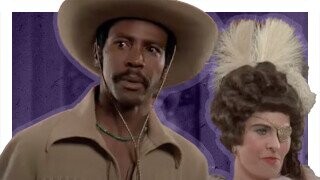The Legend of ‘Black Bart,’ the Failed ‘Blazing Saddles’ TV Adaptation

At the end of Blazing Saddles, after the massive brawl that tore down the film’s fourth wall, Cleavon Little’s Sheriff Bart decides to depart the town of Rock Ridge. The Black sheriff had saved the place, and satisfied with his accomplishment, he rode off into the sunset with the Waco Kid (Gene Wilder) to “nowhere special.”
But as it turns out, “nowhere special” would be Paris, Arizona, a small western town where Bart was appointed sheriff by the governor. Much like he did in Rock Ridge, Bart would encounter a bunch of racists who were rankled by the idea of a Black sheriff and who Bart delighted in antagonizing. At least, that would have been the case had CBS decided to go beyond the pilot stage for their TV adaptation of Blazing Saddles (though instead of calling it Blazing Saddles, for unknown reasons the network called it Black Bart, which was an earlier title of the film).
As was customary back in the 1970s, no one from the film was involved — not Little, Wilder, Mel Brooks or Richard Pryor. Even Andrew Bergman, who originated the idea for Blazing Saddles, tells me, “I had nothing to do with the pilot,” even though he’s cited as the show’s sole creator in the opening credits. Instead, the writing team of Michael Elias and Frank Shaw, who had worked on several of Bill Cosby’s early TV projects, were brought in to adapt the movie for television.
Don't Miss
Shaw passed away in 2006, but Elias — writer of many film and TV projects, including The Jerk, and the author of the new novel You Can Go Home Now — recalls his short-lived time on Black Bart fondly. “Frank and I had watched Blazing Saddles, and we loved it,” he says. “We knew Mel, and when CBS asked us if we wanted to write a Blazing Saddles TV show, we said, ‘Yes!’”
Although Black Bart operates as a follow-up to Blazing Saddles, Elias says it was meant to be its own thing, separate from the movie, but with the same basic premise of a Black sheriff in a racist town in the Old West. “We used the same basic characters but changed their names, except for Bart,” Elias explains. “For example, we had a character named Reb Jordan played by Steve Landesberg that was based on Gene Wilder’s character.” Also, despite the fact that multiple online sources claim the show is based on Bergman’s original screenplay, Elias says this wasn’t the case. Again, he and Shaw merely watched the film and went from there.
When watching the pilot — which is available on YouTube — it’s hard to say how well each of the new actors fills in for their cinematic counterpart, since each only gets a couple of minutes of screentime. However, it’s very apparent that their choice for Black Bart did a superb job. Louis Gossett Jr., who would win an Oscar for 1982’s An Officer and a Gentleman, took over for Little and he carried the part with charm and ease. “Lou Gossett was an excellent choice,” Bergman confirms.
The pilot was so strong that Elias says, prior to filming it, CBS commissioned him and Shaw to write another few episodes. “It was a lot of fun to do what was one of the last Westerns on the Warner Bros. lot,” he tells me. He particularly enjoyed the casting process for Bart’s horse. “They asked us to pick out the ‘hero horse,’” he says. “We went down, and there were like 10 horses. I swear the horses were looking at us like it was an audition. We said, ‘Lets pick a white horse for Bart, and call him Whitey.’”
“The pilot filming went well, and we all had high hopes for it,” he continues. “I still don’t know why it didn’t get picked up.”
It wasn’t a total loss, though — the show was, for a little bit at least, his ticket to a free lunch. “The guy who played the gun salesman in the beginning of the episode was a friend of mine named Jock Livingston, who was an actor, but hadn’t worked for a long time. Jock owned a restaurant in Los Angeles named Ports, and after I cast him in the pilot, I got to eat there for free for six months. Hell, had the show got picked up, I probably would have eaten free for life.”